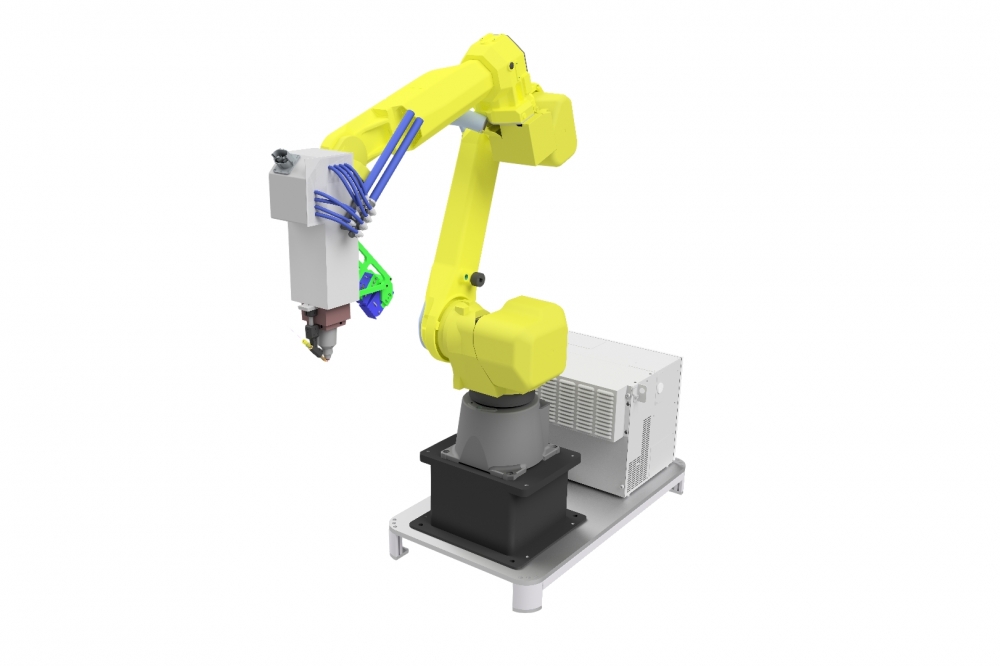FBH to show latest lasers at World of Photonics

Institute will show robotic arm with direct-diode laser system for 3D printing, latest diode laser and UV-LEDs
At the Munich trade show World of Photonics from June 27 - 30, 2023, the Ferdinand-Braun-Institut (FBH) will be exhibiting, among other things, a robotic arm with a novel direct-diode laser system for 3D printing. It will also present its diode laser and UV-LED portfolio – with advances in chip technology as well as modules and systems.
FBH and its partner companies Photon Laser Manufacturing and SKDK will demonstrate for the first time a flexible robotic arm with integrated laser beam source for Additive Manufacturing in lightweight construction. The kilowatt-class direct diode laser system features an unusual wavelength of 780 nm, which significantly improves efficiency in the fabrication of customised parts using laser wire deposition.
Due to the increased absorption, this applies in particular to the production of aluminium-based structures. Among other things, this will be used to manufacture customised side walls of high-speed trains with significantly reduced weight. Thanks to the compact size of the laser system, complex components can be manufactured even in very confined spaces. In contrast to established processing tools, it operates without optical fibres, so there is no risk of system down-time due to fibre breakage.
The basis of this and other laser systems for high-power applications are FBH's diode laser stacks. They consist of innovative vertically stacked diode lasers that can be scaled up to kilowatt power levels. These diode laser sources are used as pump sources in material processing, free-space communication, printing, and medical technology – and increasingly also directly. In parallel, FBH continuously advances the laser properties at chip level, aiming for higher power, efficiency, and beam quality.
Edge emitter with 70 percent efficiency at 70 W output power
Researchers at the Ferdinand-Braun-Institut have realised diode lasers with 70 percent efficiency at 70 W output power from a single emitter. The edge emitters with a wavelength of 915 nm are needed for pumping fibre lasers and direct use. They achieve higher powers due to the extremely wide emission apertures of 1.2 mm. The high efficiencies are based on advanced, highly vertical asymmetric epitaxial layer structures. FBH's Buried-Regrown-Implant-Structure (BRIS) technology allows a lateral periodic oxygen implantation layer to be created near the active region of the single emitter. This ensures emission within a narrow angle.
High-performance pulse laser sources
FBH develops pulse laser sources with tailored properties for various applications. The integrated laser drivers are realised at the institute as well. Among the developments are high-power pulse laser sources for line scanners in the field of automotive LiDAR to detect objects three-dimensionally. These laser sources are based on diode laser bars with 48 emitters featuring a pulse peak power of 2 kW for 8 ns long pulses. They deliver fast laser pulses that are reflected by objects they encounter.
For the MERLIN climate satellite, which will measure methane concentrations in the atmosphere in the future, FBH has realised pump lasers needed for the system, which will also be showcased at the fair. Equipped with two high-power laser half-bars, the system delivers 130 W of optical power at 808 nm in pulsed mode.
Scientists at the Ferdinand-Braun-Institut have also constructed a monolithic quantum well diode laser with a tapered gain section that generates ultrashort pulses at 780 nm. The mode-locked tapered diode laser delivers 7 picosecond long pulses with a high peak power of more than 40 W. In the future, it could replace conventional Ti:sapphire lasers as pulse sources for two-photon polymerisation (2PP), which are used to fabricate microstructures. This has already been successfully demonstrated with a single-line test structure using the 2PP technique. The test structure was fabricated using a monolithic mode-locked diode laser (830 nm) with just a single scan.
Sensor system for 3D quantum imaging
In the QUIN project, FBH is currently developing a compact sensor head for 3D quantum imaging based on optical coherence tomography (OCT). For this purpose, the researchers use entangled photons in the mid-infrared range. The information is transformed in the sensor head from the mid- to near-infrared spectral range through the entanglement process. If the sensor head is then combined with a high-resolution spectrometer in the near-infrared range, distance and structural data can be determined with previously unknown resolution.
The sensor system can thus provide precise 3D depth information using "undetected" photons in the mid-infrared range and can be used for quantum OCT for non-destructive examination of ceramic and polymer materials.


































